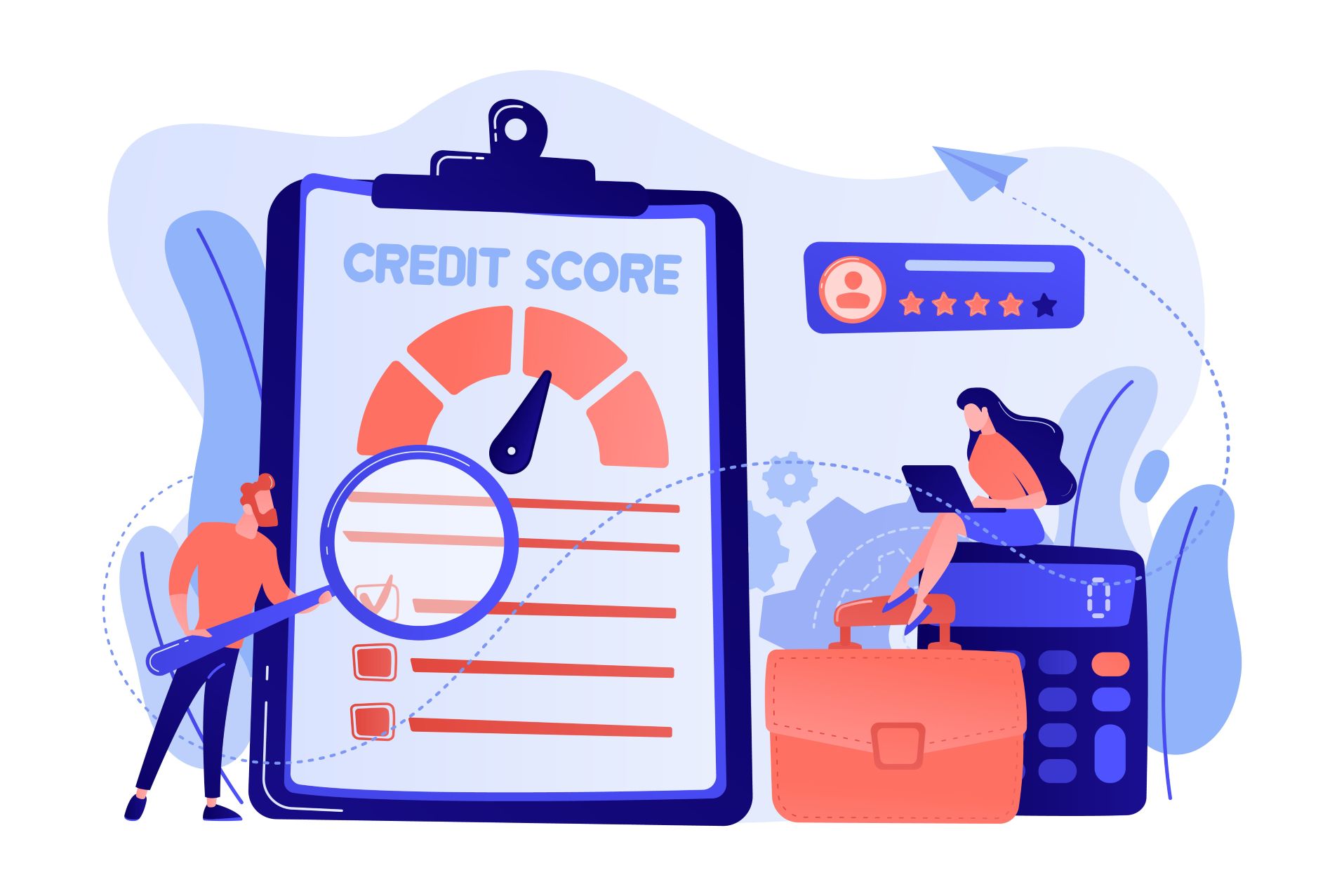Introduction
Ever dashed off an email only to remember seconds after hitting 'send' that you forgot to include your email signature? Or have you shrugged off the idea of an email footer, thinking, "It's just a few lines at the bottom; who's going to notice?"
Well, folks, let's have a chat.
Consider this for a moment. You're at a business networking event. You're meeting new people, shaking hands, and swapping business cards. But wait! Your business card is blank on one side. It has your name and maybe your phone number, but that's it. No email, no website, no social media handles. Missed opportunity, wouldn't you say?

Think of email signatures as that side of the business card you're neglecting. It's a chance to leave an impression, a friendly wave goodbye that also says, "Keep in touch; here's how to reach me." So, let's journey into the often-underestimated world of email footers and discover why every email needs one. Scroll down; Keep reading, and you'll see why this humble email component deserves a little more of your respect. Get ready to take your emails from good to great – footer first!
What is an Email Footer, and what are its components?
An email footer, also known as an email signature, is a block of text appended to the end of an email message. It often contains the sender's contact information, such as name, job title, company, and phone number. It may also include legal information, disclaimers, and links to the company's website or social media profiles.

Beyond basic contact details, the footer design is a space for branding and can feature a company logo, brand colors, or even a professional headshot. Moreover, it provides marketing opportunities, such as promoting new products, events, or blog posts. It’s a valuable tool for maintaining professional correspondence, enhancing brand consistency, providing additional information or resources, and ensuring legal compliance.
Email Footer – Importance and Best Practices
Below, we have listed the key reasons why your emails SHOULD have a footer and the best ways to design a winning one!
#1. Legal Compliance
Email footers are crucial for adhering to legal requirements set by laws like the CAN-SPAM Act (in the U.S.) and General Data Protection Regulation (GDPR, in the EU).
The CAN-SPAM Act regulates commercial emails and allows recipients to stop businesses from emailing them. According to the Act, all commercial emails must contain the following:
- A valid physical postal address of the sender.
- Clear and conspicuous explanation of how the recipient can opt out of getting email from you in the future.
For example, a business based in New York sending promotional emails to its customers would need to include its valid postal address and a clear "unsubscribe" link in the footer of every email. Failing to do so could result in penalties.

On the other hand, GDPR requires explicit consent from users before their data can be used for marketing purposes, and it gives individuals the right to know what data is being collected and stored about them.
So, for instance, a UK-based online store sending marketing emails to its customers in Germany would need to include a clear and easily accessible way for recipients to withdraw their consent (unsubscribe) and a link to the company's privacy policy in the email footer. The privacy policy should provide information on how the company collects, uses, and stores personal data.

Email footers can play a significant role in a company's legal compliance strategy by meeting these requirements.
#2. Brand Consistency
Brand consistency refers to the practice of presenting your brand in the same way across all communication channels, including language, visuals, and messaging. This consistent presentation helps to reinforce your brand's identity, making it easily recognizable and memorable to your audience.
An email footer is pivotal for maintaining brand consistency because it appears in every email you send out. By ensuring that the design, tone, and content of your email footer align with your overall branding, you can help to reinforce your brand image each time a recipient opens one of your emails.
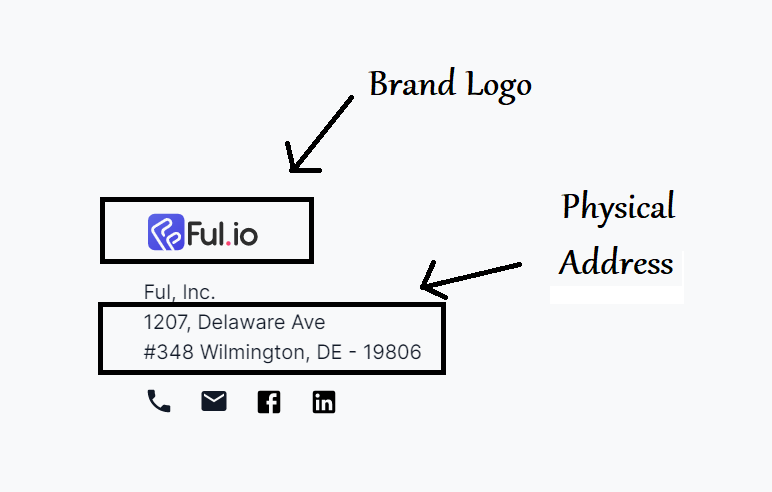
For instance, your email footer should use the same color scheme, fonts, and logo that appear in your other marketing materials. The tone and language used in any text in the footer, such as a call-to-action or disclaimer, should also match your brand's voice.
If your brand is known for a particular slogan or tagline, you might also include this in your email footer. Incorporating branding elements into your email footer makes your emails instantly recognizable to your recipients, enhancing brand awareness and loyalty.
#3. Contact Information
The email footer often serves as a go-to spot for recipients to find essential contact details, which can enhance your organization's accessibility and make it easier for individuals to get in touch.
An effective email footer typically includes information such as:
- Physical Address: This is not only legally required in some jurisdictions for business emails but also lends credibility to your organization.
- Phone Number: Including a contact number gives recipients an immediate way to reach out with queries or concerns.
- Email Address: While the recipient could reply to the email they received, providing a specific contact email (such as support or customer service) can help direct their inquiries to the appropriate place.
- Social Media Handles: By providing links to your organization's social media profiles, you offer alternative methods for people to engage with your brand.
- Website URL: Providing a link to your website can drive traffic and encourage people to learn more about your business.
- Text Communication Tools: For businesses that frequently need to share real-time updates, appointment confirmations, or support follow-ups, integrating a mass texting service into your contact methods can offer a fast, direct, and efficient communication channel.
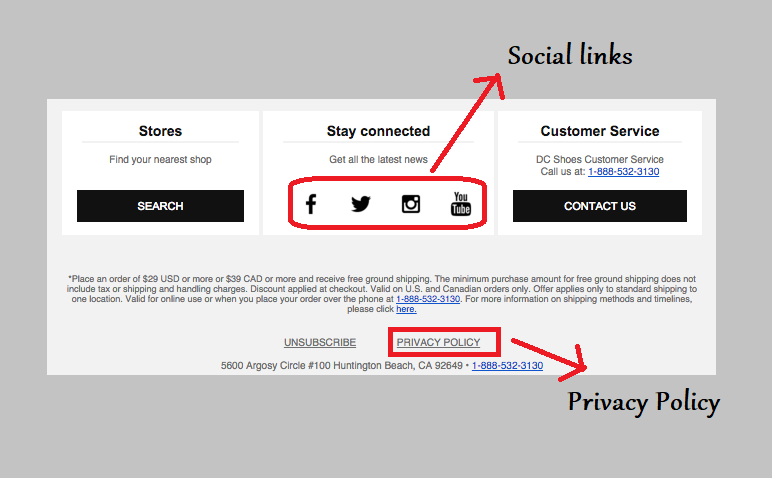
These elements collectively enhance your organization's accessibility by providing multiple avenues for contact and engagement. This improves the user experience and increases the chances of further interactions, inquiries, or potential business transactions.
#4. Marketing Opportunities
Email footers provide an excellent space for subtle yet effective marketing. They are usually the last thing a reader sees when going through your email, so they provide a final opportunity to leave an impression or direct a reader's attention to a specific action or information.
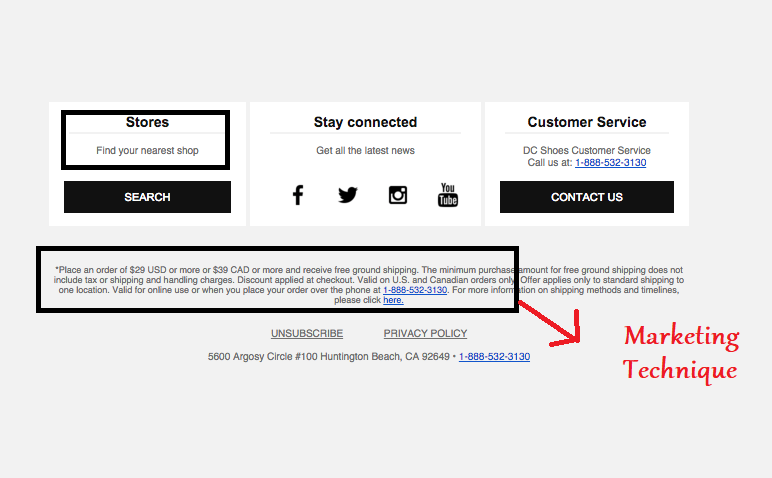
Here are some ways email footers can be used for marketing purposes:
Promoting Products or Services: The email footer can include a brief mention of the newly launched product/service along with a link for more information.
For example, "Check out our latest productivity tool here."
Announcing Events: If you're hosting a webinar, workshop, or any event, the email footer could have a brief announcement about it.
For instance, "Join our upcoming webinar on Business Strategy. Register here," with a link to the registration page.
Highlighting Social Media Profiles: Include icons linking to your social media profiles, helping increase your followers.
For example, a fashion brand can include clickable icons of Instagram, Facebook, Pinterest, LinkedIn, and other active platforms.
Showcasing Awards or Certifications: If your company has won an award or attained a notable certification, showcasing it in the email footer can build credibility.
For example, a marketing agency could include a note like, "Proud winner of the 2023 Best Creative Campaign Award".
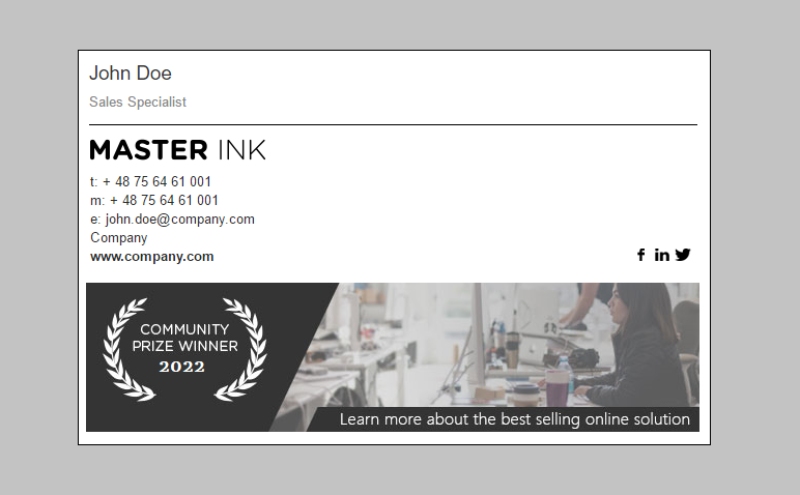
Each of these marketing opportunities adds value to the reader, providing them with links or information that they may find useful or interesting while also promoting your brand and offerings.
#5. Trust and Credibility
An email footer is not just a throwaway part of your communication. A well-crafted email footer can help to build trust and credibility with your audience. Here's how:
As mentioned earlier, aspects like
Contact information with a physical address eliminates shadiness. Recipients can see that you're a legitimate business and have easy ways to reach you if desired.
Brand image with the same layout, logo, fonts, and colors in every communication reinforces your identity and makes your brand feel more reliable and trustworthy. Using a color wheel can help you select harmonious color combinations that reflect your brand’s personality. This ensures consistency while also creating a visually appealing and memorable identity.
A well-designed, organized, and informative email footer shows that you pay attention to detail and care about communicating with your audience. This professionalism can help to build your credibility.
Displaying legal information, registration details of the company, privacy policy links, and unsubscribe options demonstrates transparency and signals to your audience that you respect and adhere to these rules
Link to your website (a well-built one containing your body of work, clientele, and testimonials) acts as a strong social proof of your expertise, experience, and accomplishments, enhancing your credibility.

#6. Engagement
Whether you send cold emails pitching for sales or follow-up emails to converted leads, you know that CTA is essential mail manners. The space set for your footer can be an excellent choice to include an ideal call-to-action phrase pushing your leads/audience to act further.
Here are a few ways that email footers can boost engagement through CTAs:
- Website Visit: "Visit our website to learn more" or "Check out our latest blog post."
- Social Media Engagement: This might look like "Follow us on Twitter for the latest updates!"
- Newsletter Subscription: The footer could include a CTA prompting them to subscribe to your regular newsletter: "Don't miss out – subscribe to our weekly newsletter!"
- Feedback Request: "Tell us how we're doing – leave a review!"

By strategically placing these CTAs in your email footer, you can increase the chances of your audience taking the desired actions, thus fostering greater engagement with your brand.
#7. Copyright Protection
Displaying copyright information in your email footer is a simple but essential step in protecting your intellectual property. While it's not a foolproof method against infringement, it serves as a clear reminder that copyright laws protect the content of your email.
Email content, like any other original work, can be subject to copyright. This includes text, graphics, creative logos, images, and other creative expressions.

By including a copyright notice (e.g., "© 2023 Your Company Name. All rights reserved."), you assert your ownership over the content and remind recipients that they do not have the right to use it without your permission.
Please note, however, that a copyright notice does not replace official copyright registration. Consider consulting with an intellectual property attorney or professional for the most comprehensive protection of your intellectual property.
Conclusion
And there you have it! From legal compliance to branding and marketing opportunities, a simple email footer punches well above its weight. It's not just an off-the-cuff line at the end of your communication. Instead, it's an integral part of your overall email strategy, with the potential to engage, inform, and leave a lasting impression on the reader. It is the last chance to communicate crucial information, The final note that often plays in the back of the reader's mind. So, don’t let this real estate go to waste. Remember, every little detail about your email contributes to your brand image.
As Aristotle once said, "The whole is greater than the sum of its parts." And in the case of your emails, it's not just the content but also the footer that completes the picture, contributing to the overall professionalism, credibility, and effectiveness of your communication.
So, next time, before you click that send button, take a moment to consider your footer. It might just be the most important part of your email you're neglecting. Keep it neat, informative, and on-brand. It's the finishing touch your emails deserve!

